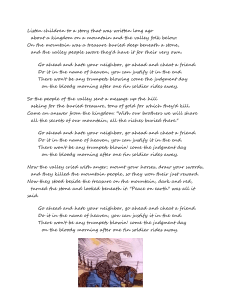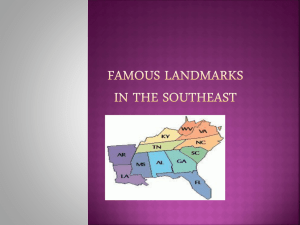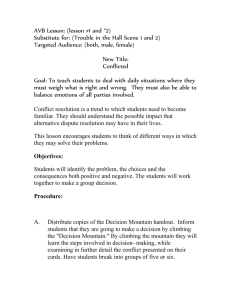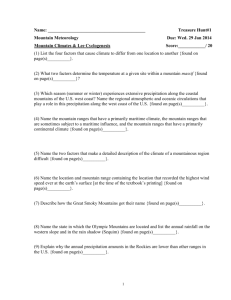File - IBCC ATL COURSE
advertisement
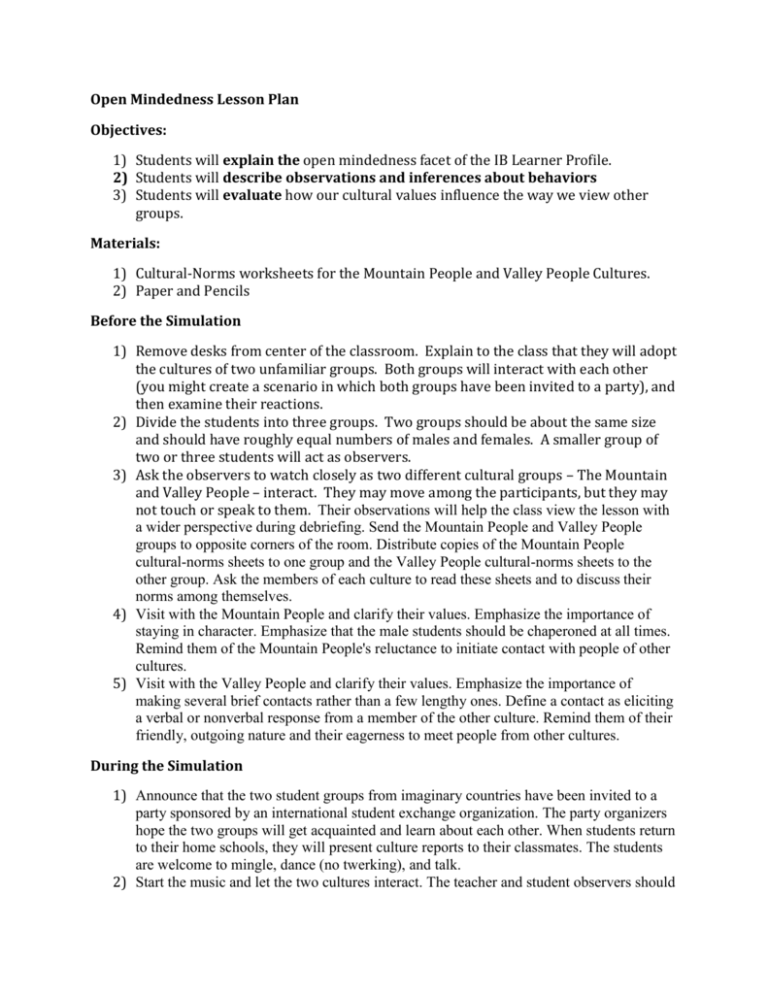
Open Mindedness Lesson Plan Objectives: 1) Students will explain the open mindedness facet of the IB Learner Profile. 2) Students will describe observations and inferences about behaviors 3) Students will evaluate how our cultural values influence the way we view other groups. Materials: 1) Cultural-Norms worksheets for the Mountain People and Valley People Cultures. 2) Paper and Pencils Before the Simulation 1) Remove desks from center of the classroom. Explain to the class that they will adopt the cultures of two unfamiliar groups. Both groups will interact with each other (you might create a scenario in which both groups have been invited to a party), and then examine their reactions. 2) Divide the students into three groups. Two groups should be about the same size and should have roughly equal numbers of males and females. A smaller group of two or three students will act as observers. 3) Ask the observers to watch closely as two different cultural groups – The Mountain and Valley People – interact. They may move among the participants, but they may not touch or speak to them. Their observations will help the class view the lesson with a wider perspective during debriefing. Send the Mountain People and Valley People groups to opposite corners of the room. Distribute copies of the Mountain People cultural-norms sheets to one group and the Valley People cultural-norms sheets to the other group. Ask the members of each culture to read these sheets and to discuss their norms among themselves. 4) Visit with the Mountain People and clarify their values. Emphasize the importance of staying in character. Emphasize that the male students should be chaperoned at all times. Remind them of the Mountain People's reluctance to initiate contact with people of other cultures. 5) Visit with the Valley People and clarify their values. Emphasize the importance of making several brief contacts rather than a few lengthy ones. Define a contact as eliciting a verbal or nonverbal response from a member of the other culture. Remind them of their friendly, outgoing nature and their eagerness to meet people from other cultures. During the Simulation 1) Announce that the two student groups from imaginary countries have been invited to a party sponsored by an international student exchange organization. The party organizers hope the two groups will get acquainted and learn about each other. When students return to their home schools, they will present culture reports to their classmates. The students are welcome to mingle, dance (no twerking), and talk. 2) Start the music and let the two cultures interact. The teacher and student observers should walk among the groups looking for behaviors that can be described and discussed during debriefing. 3) After 10 to 12 minutes, call time and end the party. Ask the students to meet once more in opposite corners of the room and to make notes for their culture reports. 4) Give each group about 10 minutes to create a brief report. The Valley People’s report will describe Mountain People’s behavior and the values that their classmates could expect to encounter if they visited the Mountain People nation. The Mountain People will create a similar description of the Valley People’s culture (Instead of one group report for each culture, students might split into small groups so that a larger sample of culture reports can be analyzed during the debriefing). 5) Ask a representative from the Valley People to present the group's report to the class. Then, after providing the Valley People with a copy of the Mountain People’s cultural norms, ask a representative from the Mountain People to read that group's norms sheet. Ask the Valley People to note how their report compared with the Mountain People’s cultural-norms sheet. Repeat with Mountain People’s report. Take notes on board as report is presented. After the Simulation: Discussion and Debriefing Use questions such as the following to guide discussion of how our own cultural biases influence the way we view other groups. Be sure to ask the small group of observers for their views on the participants' attempts to communicate across cultures and to maintain cultural norms. 1) How did you feel about the behavior of your own group’s members? Of the other group? 2) Did your group's culture report use positive, negative, or neutral terms to describe the other group? 3) How well did your group members observe the norms of their assigned culture? During the party, what did you do if a member of your culture did not observe a particular norm? 4) What are the real-world advantages of following cultural norms? 5) What are some real-world situations that were illustrated during the game? 6) Mountain People women were instructed to speak for the Mountain People men. In what real-world situations does one group speak for another? 7) How would the game be different for players if the Mountain People men dominated the women? 8) What lessons from this activity would you want to keep in mind if you were going to spend time in an unfamiliar culture? Also ask students to also discuss whether they agree or disagree with each of the following statements: 1) 2) 3) 4) People have difficulty describing the behaviors of other groups in non-judgmental terms. People acquire cultural norms fairly quickly. Most of the group's norms are maintained through peer pressure. Americans tend to feel uncomfortable without eye contact, even though in many parts of the world, eye contact is considered to be rude and impolite. 5) The same behavior can be perceived differently based on your group’s norms. After the Discussion Post the IB Learner Profile, highlighting Open Mindedness as the feature that the Social Studies Department will be focusing on. Students might write a reflection detailing goals that they have, ways in which they have/have not been open minded in the past, personal barriers that they have to being open minded, etc. Extensions 1.Students share their personal experiences about living, visiting, or experiencing different cultures or countries. 2. Students create a public service announcement (PSA) about open mindedness for Taft. The PSA will include a definition, examples, and an statement about the importance of open mindedness. Group Report: List five observations: Make five inferences about your observations: What do you think the “other” people value in their society based on your encounter? What did you feel during the encounter? How did you handle being introduced to a group of people that were “different”?

